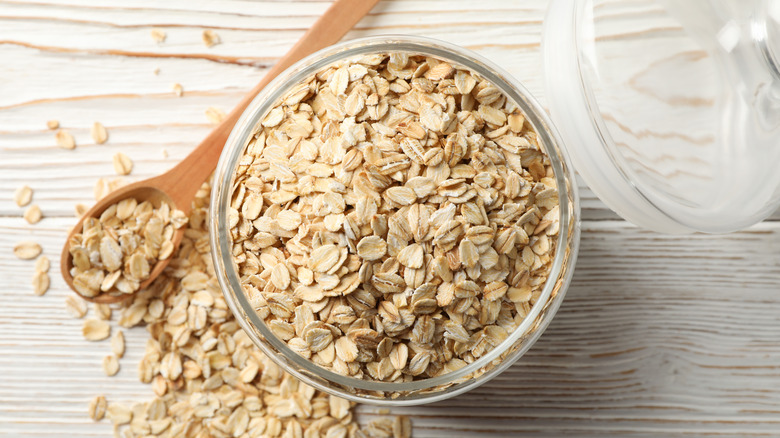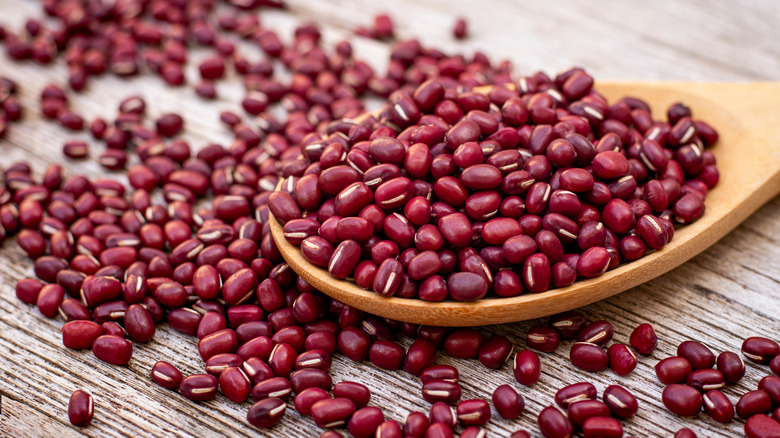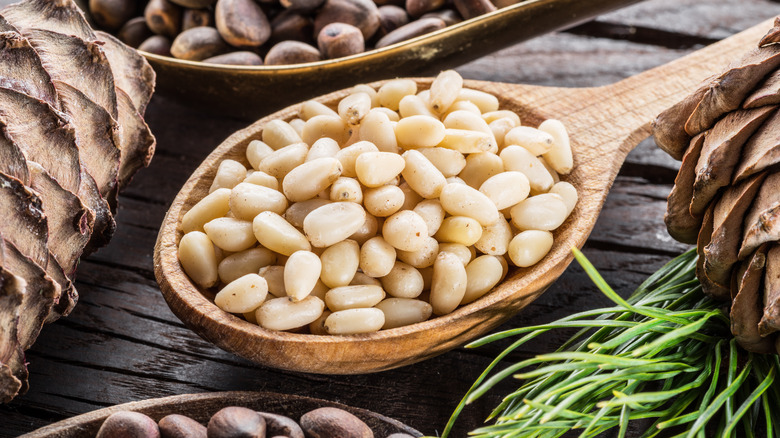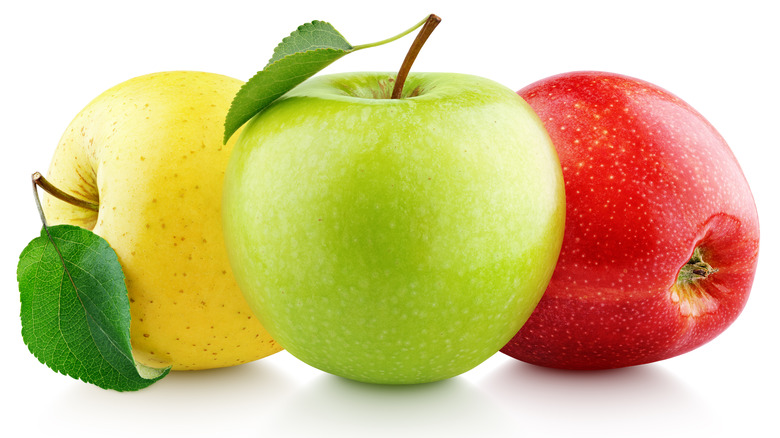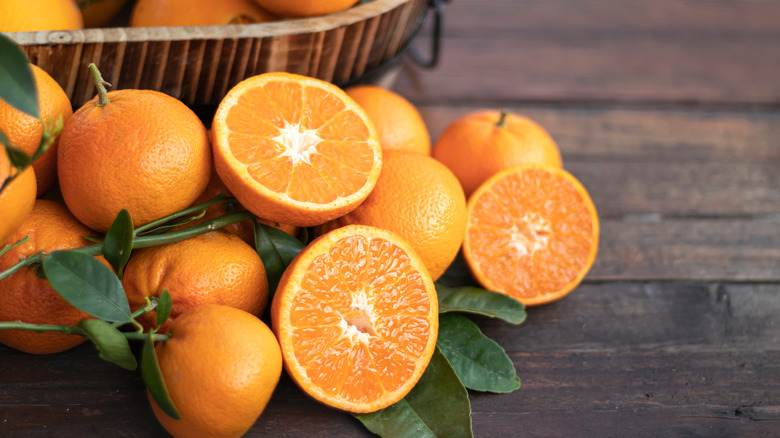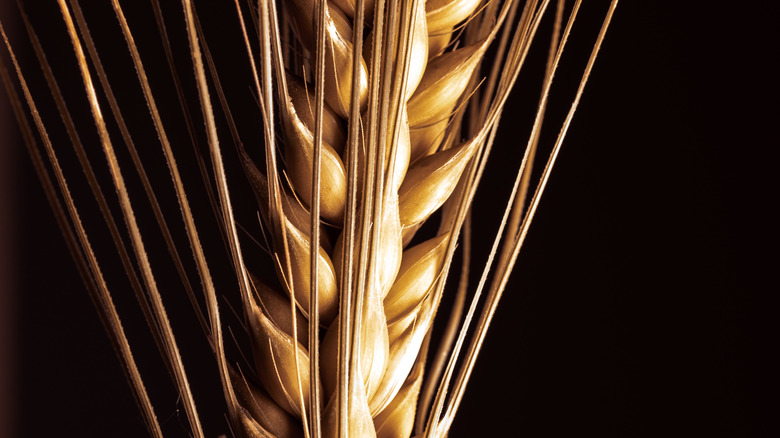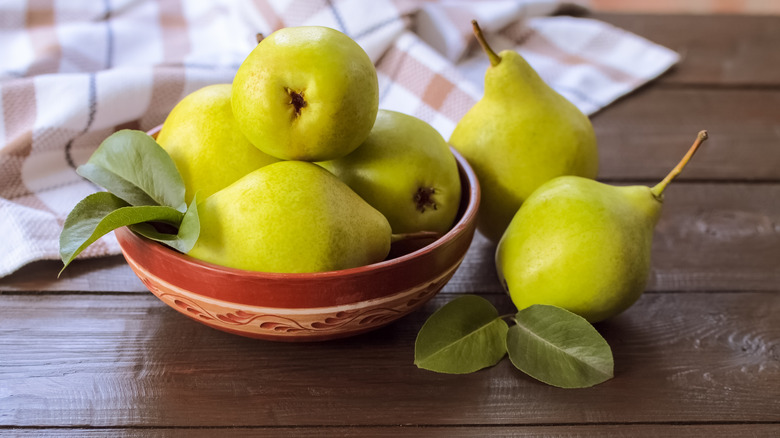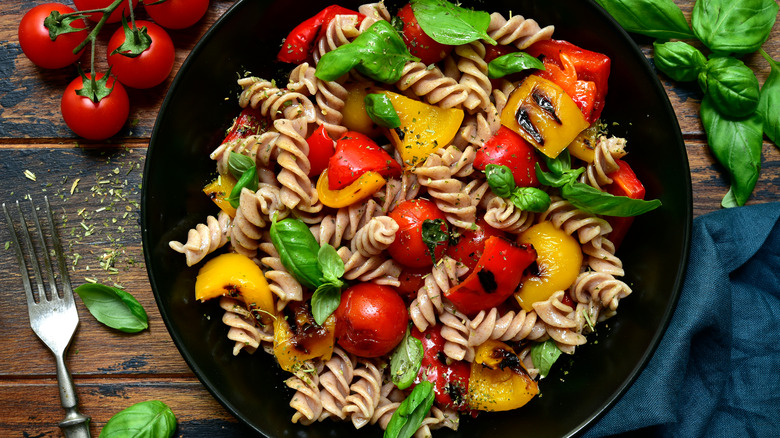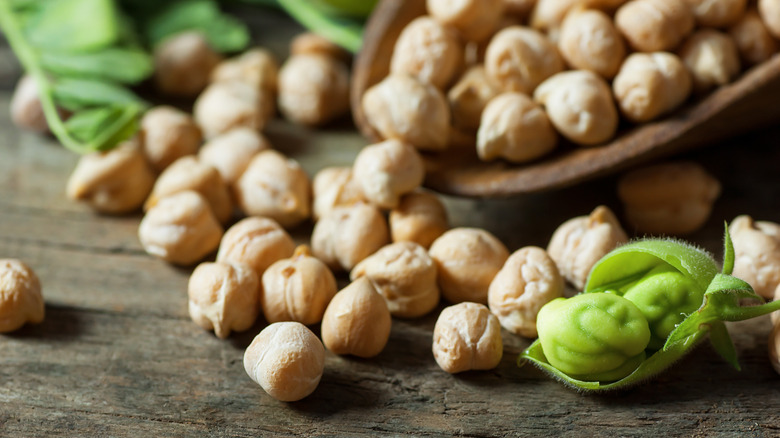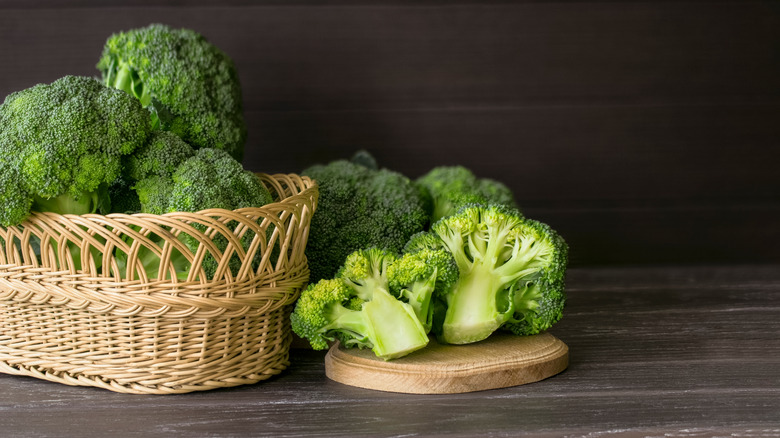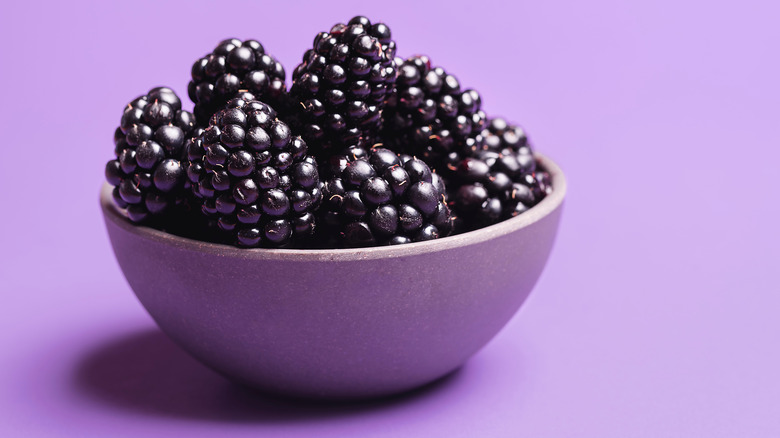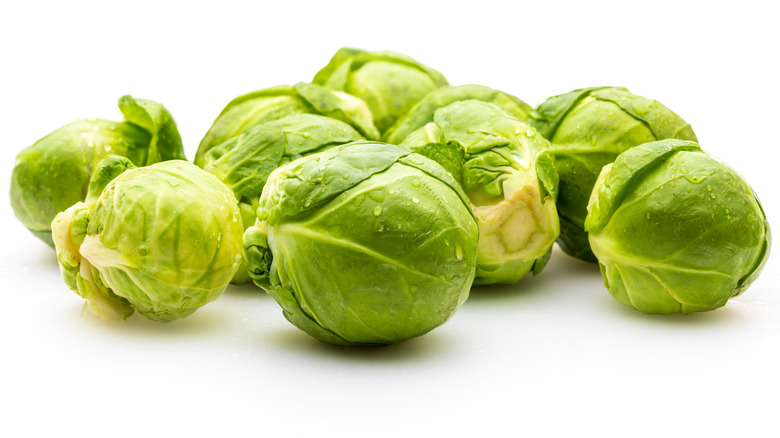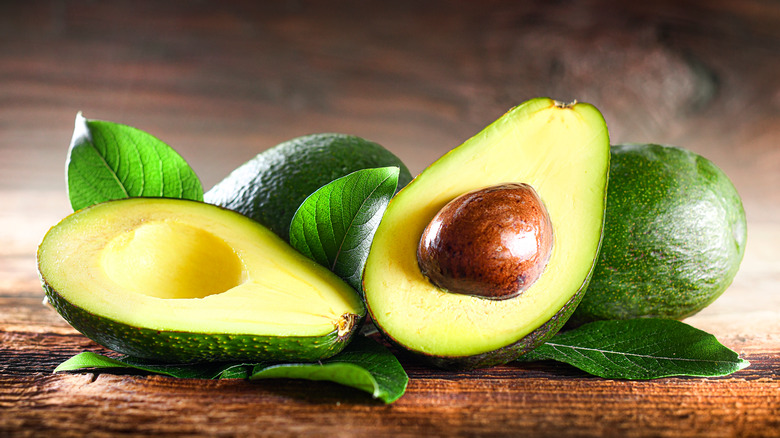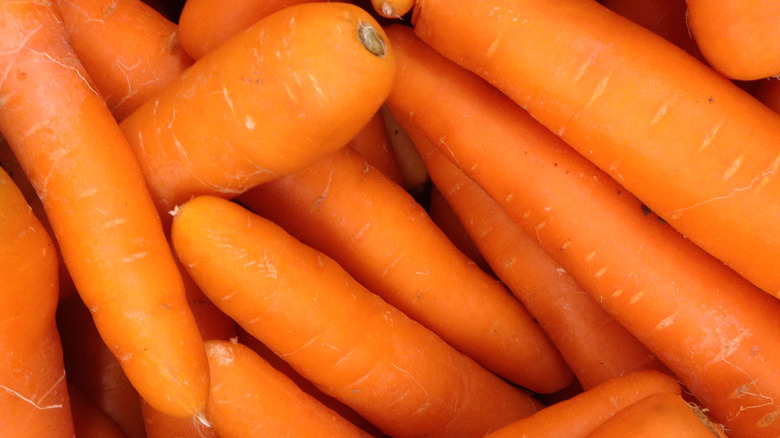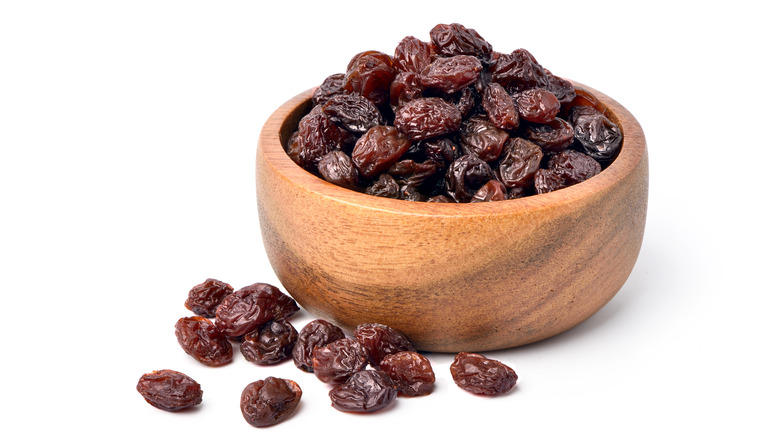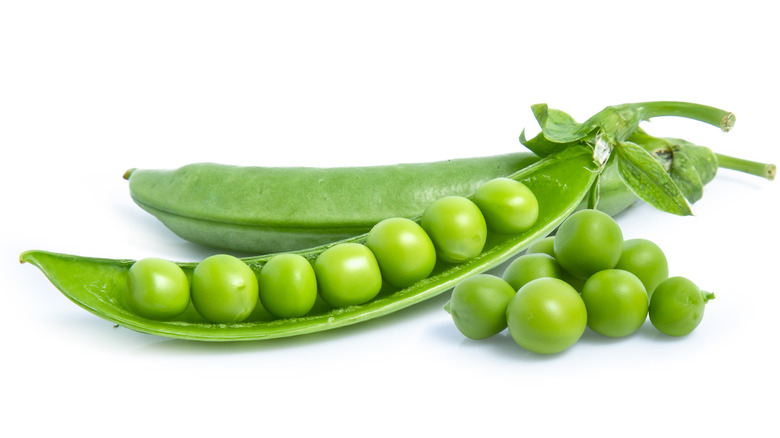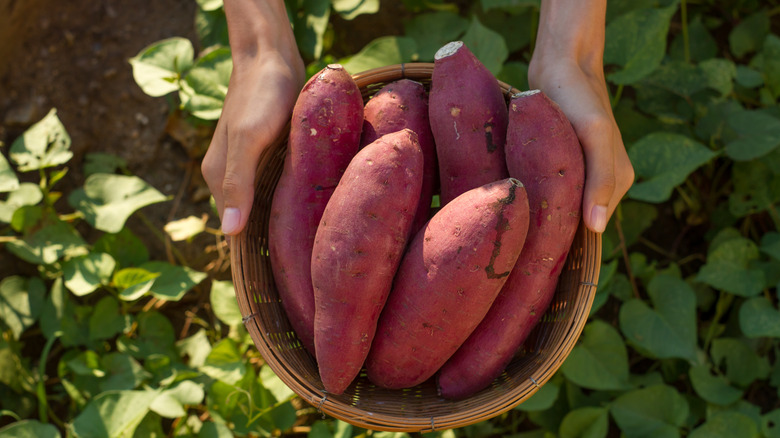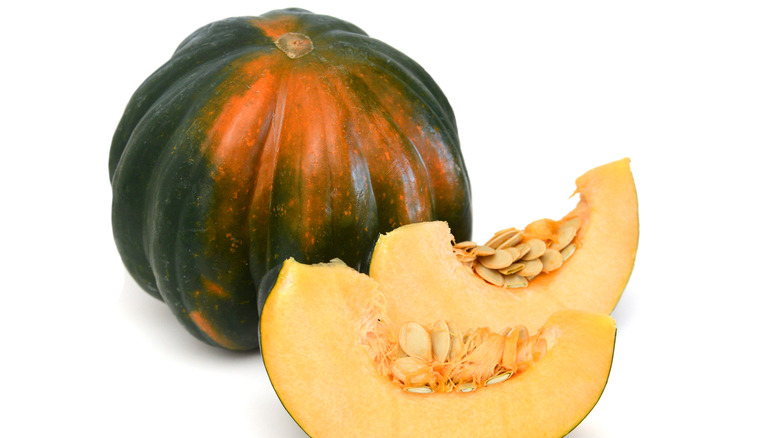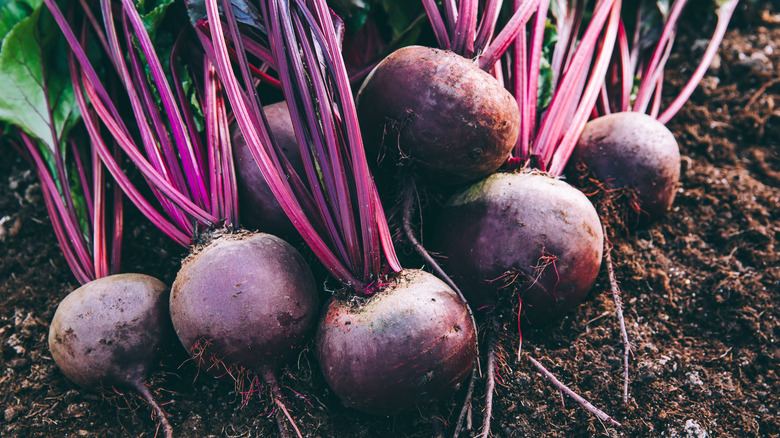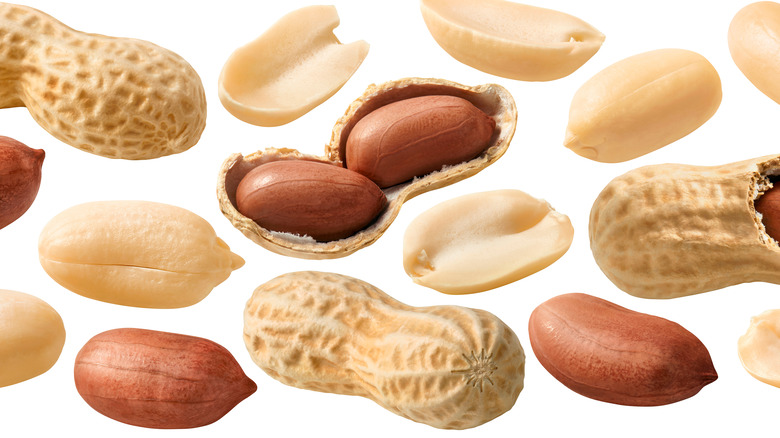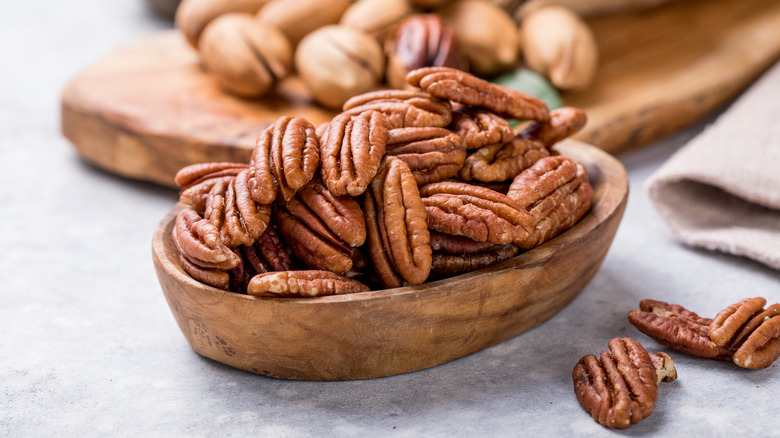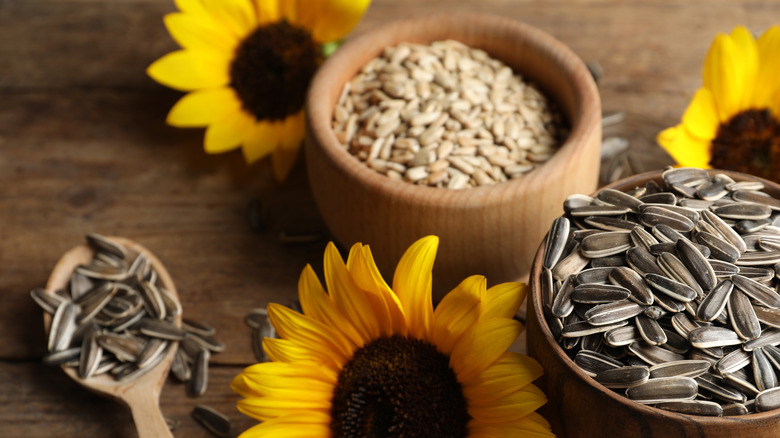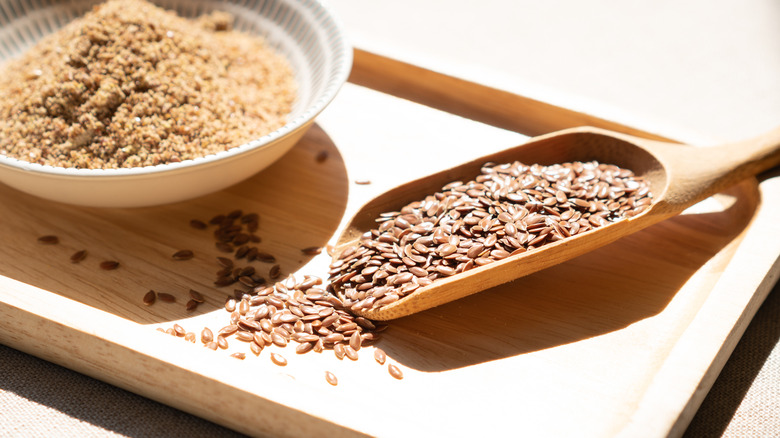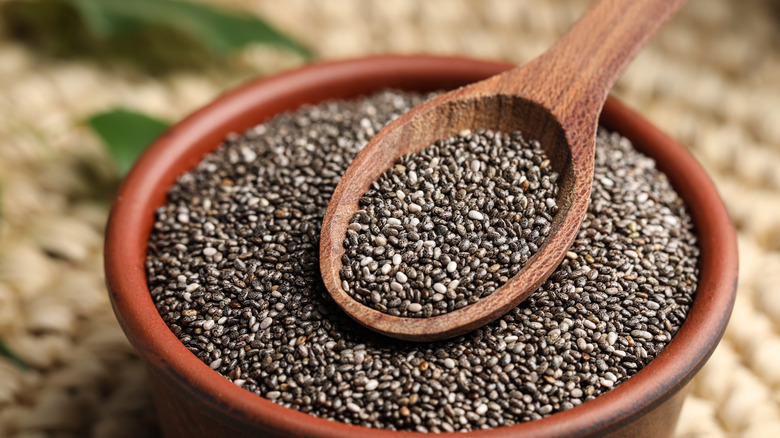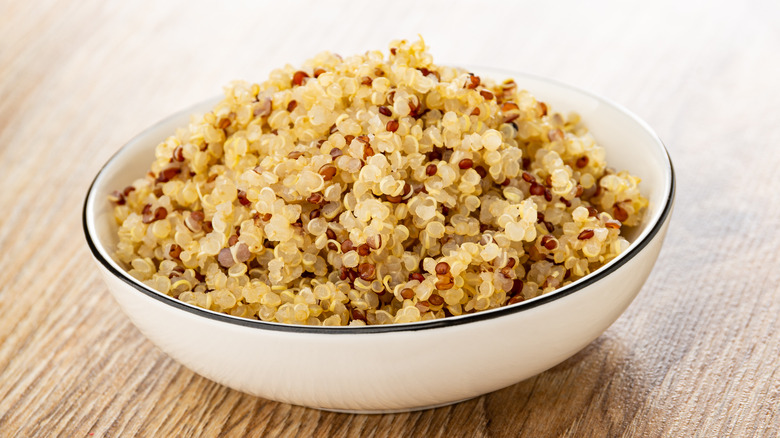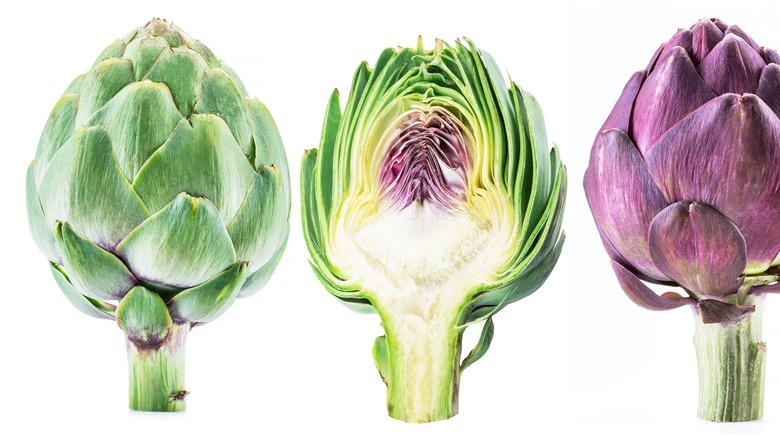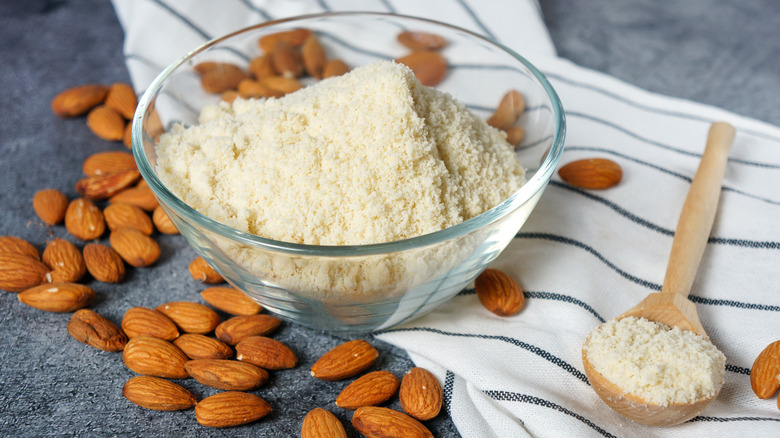Eat These 29 Foods If You Need More Fiber
Get ready for a shock. We've all heard how important it is to get enough fiber. Just browse a vitamin aisle, and chances are you'll see fiber in powders, supplements, and even chewable gummies. But did you know that an important reason why fiber is so crucial for good health is because you don't digest it?
Yes, as wild as it sounds, the word "fiber" actually refers to a variety of carbs that aren't broken down like other foods by the time they leave your stomach (via Healthline). And while this sounds like it would be bad for your system, fiber can be great for your colon. This is because your colon has bacteria in it (don't worry, the good kind), which consume different types of fiber. And you definitely want these bacteria well-fed because odds are if they're healthy, you're healthy.
So eating fiber supports good colon health, which can positively affect the rest of your body in a number of ways, ranging from reducing cholesterol to controlling blood sugar (via Healthline). Yet, only around 5% of Americans eat enough fiber on a daily basis. How much is the right amount? Well, your age and your sex are factors, but the Institute of Medicine advises 19 to 38 grams a day, according to a report in American Journal Lifestyle Medicine. Fortunately, there are plenty of foods loaded with fiber that can help you up your intake of this important carb.
1. Oats
Chances are you're familiar with this fiber-rich food. After all, oatmeal is one of the healthiest breakfasts you can eat. But what really makes these little gluten-free grains such healthy powerhouses is not just that they can provide you with 8 grams of fiber (based on 78 grams of dry oats), but also because of the type of fiber they have (via Healthline).
As Healthline revealed, oats are packed with beta-glucan fiber. This type of fiber is so beneficial because it's a soluble fiber, meaning that when it mixes with the water in your body, some of it turns into a gel. And, yes, this transformation beta-glucan fiber goes through is different than regular digestion since it only changes the fiber's form rather than breaks it down. By becoming a gel, soluble fiber makes your stomach empty more slowly, which is why you feel fuller longer after, for example, eating a bowl of oatmeal and why fiber can help with managing your sugar and weight.
In addition, the beta-glucan fiber found in oats can help maintain healthy cholesterol levels, which is great for your heart's health (via Healthline). For elderly individuals, research is finding that the bran part of oats may help improve their digestive health, so they are less constipated. Plus, oats are a good source of protein and are loaded with other important nutrients like manganese, copper, potassium, calcium, and vitamins B1, B3, B5, and B6.
2. Beans
We've all heard about how beans are "the musical fruit," and half of that silly poem is true. According to Medical News Today, beans are actually legumes, which are a family of plants that also include peas and lentils. The good news is legumes are loaded with fiber. The not-so-good news is beans are "musical" because they have fermentable fiber.
According to Healthline, the good bacteria in your digestive system consume fiber, like the kind found in beans. This process is called fermenting, and while it's positive for your overall health, it causes gas. This isn't pleasant and can be embarrassing (bean burritos may not be the best choice for a first date). But fermenting also produces short-chain fatty acids (SCFA), which might lower your chances of developing cancer, as well as issues with your heart (via Journal of Clinical Gastroenterology). Plus, these fatty acids can cut down the likelihood of developing problems with your GI (gastrointestinal) tract like polyps on your colon and hemorrhoids (via Cleveland Clinic).
While beans, in general, are a good source of fiber, navy beans are one of the best choices if you want to increase your fiber intake (via Healthline). Other fiber-rich members of the legume family include soybeans, kidney beans, pinto beans, lima beans, black beans, and mung beans. And if you're looking for something sweet, adzuki beans are packed with fiber and the prime ingredient for the paste used in such snack treats as Taiyaki.
3. Pine nuts
Although pine nuts are a good source of fiber, there are a few things you should know before adding them to your diet. For starters, pine nuts are the seeds, not nuts, from certain species of pine trees (via Verywell Fit). They come straight from the pinecone, but only certain species of pine trees have seeds that are safe to eat.
With that said, the fiber and magnesium in pine nuts are good for managing blood sugar (via Verywell Fit). Plus, pine nuts may also lower your chances of developing colon cancer and help support your digestive health because they contain both antioxidants and fiber. And it's believed that a portion of the calories in a pine nut come from its fiber. Remember, fiber isn't digestible, so this could make these little seeds a great choice for weight management.
Although there are quite a few possible benefits from eating pine nuts, there are also a couple of health cautions. Anyone with a peanut or pine tree pollen allergy could have an allergic reaction to pine nuts that can include vomiting, developing hives, and even anaphylactic shock, which can be fatal (via Verywell Fit). In addition, some people can have a genetic disorder called pine nut syndrome or "pine mouth", in which they have a bitter taste in their mouth starting a few days after eating pine nuts. Unfortunately, that metal-like flavor could linger for as long as four weeks.
4. Apples
No food quite symbolizes good health like the apple. Well, Snow White might disagree with that, but not counting the "poisoned by an evil queen variety," this fruit is a healthy, crunchy treat packed with nutrients, antioxidants, and, yes, fiber (via Medical News Today).
As research supports, if you consumer fiber, you're less likely to have a stroke (via Medical News Today). What's more, one study found a link between eating apples and a lowered chance of having a thrombotic stroke or a stroke caused by a blood clot. In addition, research supports that fiber-rich apples can help lower cholesterol as long as you eat the fruit rather than just drink the juice. Another study found eating fiber can reduce your chances of developing coronary heart disease and cardiovascular disease. And this makes sense since the fiber in apples can be beneficial for your blood pressure, which means your heart is less strained and so less likely to develop problems.
In addition to fiber, apples also are a good source of vitamin C and potassium both of which can help you keep your heart healthy (via Medical News Today). Plus, apples can be good for managing blood sugar, but there is a catch. It's the fiber in apples that can help keep your sugar levels from spiking too high, but remember, apples do have natural sugar. So you may want to speak with your health care professional about the best way to incorporate them into your diet.
5. Citrus fruits
Whether you like blending oranges into an immune-boosting smoothie, making lemon bars for a creamy dessert, or enjoying a slice of grapefruit at breakfast, there's nothing quite like sweet, tangy citrus fruits. But besides all the usual nutrients these natural treats are known for, like vitamin C, citrus fruits are packed with two types of fiber.
As registered dietitian Wendy Bazilian told Health, a third of the fiber in citrus fruits is insoluble while the rest is soluble. Remember, fiber is not digested, but soluble fiber combines with the water in your body, so it becomes a gel-like substance. Insoluble fiber, on the other hand, is basically unchanged as it leaves your stomach. Because of this, insoluble fiber adds bulk, which can help keep you regular, and soluble fiber can improve your blood sugar levels since its gel form forces your stomach to empty more slowly, leaving you feeling fuller longer (via Healthline).
In addition, the soluble fiber in citrus fruits can aid in maintaining healthy cholesterol levels (via Verywell Health). In its gel form, soluble fiber passes through your digestive system and combines with a type of acid found in your small intestine called bile acids. Remember, bile is made by your liver to help break down fat, and cholesterol is needed to create bile. Since the soluble fiber takes the bile acid with it when it's excreted, your body draws cholesterol from your blood to produce more bile, and so your cholesterol goes down.
6. Barley
Let's get something out of the way. Barley is used to make whiskey and beer — but just because something has barley in it, that doesn't make it a good source of fiber (via Healthline). When it comes to this widely produced cereal grain, you need to keep two words in mind: hulled and pearled.
When barley is hulled, very little is done to it by its manufacturers. The only real change is it no longer has its outer shell. When barley is pearled, however, manufacturers take out the bran, which also removes fiber, Healthline explained. And unfortunately, that means pearled barley (which you're more likely to find at the supermarket) is less likely than hulled barley to help with health concerns like digestive issues and weight management. In fact, barley naturally has a type of fiber called beta-glucan, which might good for managing your blood sugar and cholesterol levels.
So how much fiber can you get from barley? Well, as Healthline noted, 100 grams of hulled barley that have not been cooked has a whopping 17.3 grams of fiber. And besides its fiber content, barley is also rich in protein and antioxidants, as well as vitamins like riboflavin and niacin and minerals like iron, zinc, and magnesium.
7. Pears
Whether you like them poached or in a pie, pears are an especially sweet and tender fruit. And if you're concerned that its nutritional value isn't as good as it seems, don't worry. This is one fiber source that lives up to the hype. In fact, research published in Nutrition Today revealed that pears need to be studied further in part because they are so high in fiber.
A medium-sized pear is packed with 6 grams of fiber (29% of which is soluble, and 71% is insoluble). Keep in mind that a tangerine has 1.6 grams of fiber, and an orange has 2.3 grams of fiber (via Health). In addition, the fiber in pears contains a substance called lignins, which act like cement that help to hold plants' cells together, per Nutrition Today. These lignins have a similar impact on your body as antioxidants.
Besides fiber, pears are rich in potassium and vitamin C, and research has found that pears (like apples) may help reduce your chances of having a stroke and developing type 2 diabetes. Plus, pears have both sorbitol, an alcohol found in some species of fruit, and a type of sugar called fructose. These two substances together with the fiber can help keep you regular, as well as support your digestive system. However, you do want to be careful. There have been cases of sorbitol and fructose possibly causing diarrhea in children.
8. Whole-wheat pasta
Chances are you've had more meals made from classic white flour pasta than its fiber-rich, whole-wheat "cousin." But what is the real differences between these similar carb-loaded foods? As registered dietitian Alicia Romano told Time, whole-wheat pasta, as its name suggests, comes from the wheat's entire grain kernel while white flour pasta is made from a refined version of the kernel that is missing vitamins, minerals, and other nutritional elements. So every time you eat some whole-wheat pasta, you're getting mouthful after mouthful of key nutrients, including fiber.
In fact, according to Time, a single cup of cooked spaghetti made from white flour has only 9% of the recommended daily intake of fiber. And how much does the same amount of whole-wheat pasta have? A whopping 23% — more than double white-flour pasta. And this amount of fiber definitely makes an impact on your health. Dr. Mette Kristensen, associate professor at the University of Copenhagen's department of nutrition, exercise and sports, explained to Time that the fiber in whole-wheat pasta helps increase the levels of good bacteria in your gut, improving your digestive health.
In addition, whole-wheat pasta can support weight management. As Dr. Mark Pereira, an epidemiologist, told Time, this fiber-rich, bulkier pasta is "more satiating," making it an effective way to curb your appetite. However, one word of caution: A product advertising it's made from wheat pasta is not necessarily the same thing as whole-wheat pasta, so check your food labels.
9. Chickpeas
Like beans, chickpeas are a member of the legume family and are an excellent source of fiber (via Medical News Today). Although they're tiny compared to other foods on this list like broccoli or apples, 164 grams of these legumes can give you 12.5 grams of fiber. But their fiber content is just part of how they can help you live a healthier life.
As Medical News Today explained, the chickpea is also a great source of minerals like selenium, iron, potassium, and magnesium. It's also packed with B vitamins. Combine all of these with its fiber, and you have a heart-supporting team of nutrients. In addition, research supports that the fiber in chickpeas can help you manage your cholesterol by lowering your cholesterol. In fact, chickpeas are a cholesterol-free food, so not only do they not introduce more cholesterol into your system, but they also help you get rid of LDL ("bad") cholesterol that's already there. And, of course, controlling your cholesterol is better for your heart.
In addition to helping keep your heart healthy, chickpeas, like many fiber-rich foods, can help you manage your weight by helping you feel fuller longer (via Medical News Today). However, if you have irritable bowel syndrome or IBS, then consuming foods high in certain types of fiber can intensify your IBS symptoms. So, whether you're thinking of eating more chickpeas or just more fiber in general, you should first speak with your medical professional.
10. Broccoli
Poor broccoli. It's constantly branded as one of the least popular foods — especially if you're trying to cook for children. But don't sell this member of the cruciferous family of vegetables short. It's not called a superfood for nothing; its fiber content is a big part of what makes it a healthy addition to your diet.
As Medical News Today explained, just 76 grams of broccoli can provide you with up to 7.1% of the recommended amount of fiber you should consume daily. And it's a good thing, too, because fiber can help reduce your chances of developing colon cancer and cardiovascular disease. In addition, the fiber you can from broccoli and other food sources can support good digestive health, keeping you regular. Plus, there is evidence that if you have Type 2 diabetes, a little fiber-rich broccoli can help you keep your blood sugar from spiking and dipping.
Besides being a great source of fiber, broccoli is packed with other valuable nutrients like potassium, as well as antioxidants (via Medical News Today). In fact, one of the antioxidants, sulforaphane, is why broccoli has a bit of a bitter taste. But, like fiber, it also makes you less likely to develop cardiovascular disease. Plus, broccoli has been shown to support your immune system and help keep your skin and bones healthy. So, even if you're not broccoli's biggest fan, don't pass it up next time you go grocery shopping. Instead, you may want to consider other ways to prepare this superfood.
11. Blackberries
From sprucing up oatmeal to adding extra sweetness to smoothies, blackberries are a definite favorite food for living a healthier life. And while you'd expect these little berries to have antioxidants and vitamins like C and K, they are also an excellent source of fiber (via Health). In fact, just 1 cup of blackberries provides you with 8 grams of fiber (although that number goes down if they are frozen).
Like many foods that are loaded with fiber, blackberries are great for managing your blood glucose levels. But as anyone who has to watch their sugar will tell you, keeping those levels steady means also not consuming too much sugar. And if you have a sweet tooth, that can be a challenge. The good news is blackberries are very low in natural sugar. Case in point: While a cup of blackberries has only 7 grams of sugar, a cup of pineapple chunks would be more than double that amount. These berries should be on your radar if you're diabetic or at risk of developing diabetes.
In addition, fiber-rich blackberries are great for your colon, immune and digestive systems, and cholesterol (via Health). They can help reduce inflammation in the body (including in your brain), which is a common side effect of an infection. Plus, they are excellent for your bones and your skin, and may even increase your body's production of serotonin, which is a chemical that helps you get a good night's sleep.
12. Raspberries
Raspberries have an unmistakably tangy-sweet taste that makes them a very popular ingredient in desserts. And like other foods on this list, it's a combination of the fiber and other nutrients in raspberries that makes them so healthy.
Along with other members of the berry family, raspberries are packed with fiber (via Healthline). In fact, 123 grams of raspberries give you about 8 grams of fiber. Besides not spiking your blood sugar, research is finding that raspberries can improve how your body uses its insulin, as well as help you manage your blood sugar levels. And this is in part because raspberries are loaded with fiber but also because these berries have a great deal of a substance called tannin, which makes your body less likely to absorb all the carbohydrates from a meal. However, just because raspberries may help you control your sugar doesn't mean you can stop exercising proper portion control.
In addition to helping with sugar, raspberries may assist with managing weight not just because of their fiber content but also because their sweet taste may make you less likely to reach for a less healthy sugary treat. And for an extra healthy kick, you may want to try eating them combined with other berries. But keep in mind raspberries tend to spoil more quickly than other foods, so the sooner you eat them the better.
13. Brussels sprouts
Brussels sprouts are almost a cliché when it comes to finicky eaters and in particular children. Even with tips to make them crispier, they usually aren't high on anyone's list of favorite foods. And it's a shame because these green vegetables are not only low in carbs and calories but also packed with fiber and vitamins (via Health).
According to Health, this healthy plant has 3 grams of fiber per cup uncooked, which along with its natural antioxidants (like alpha-lipoic acid) have been shown to help your body use its insulin better. In fact, Brussels sprouts can help reduce your chances of developing diabetes. And, of course, like most fiber-rich foods, these often maligned side dishes may help keep your digestive system functioning properly, improve your mood, and give your immune system a boost.
But besides its fiber, Brussel sprouts contain huge amounts of vitamin C (via Health). And, no, that's not hyperbole. When cooked, they pack 150% more than the recommended minimum daily amount of this vital vitamin per cup. So, the next time you want to shove them aside on your plate, remember, these little vegetables are fantastic for your eyesight, plus the fact that they help your body better absorb iron. And if that weren't enough motivation for you to give them a try, then how about that Brussels sprouts are also exceptionally high in vitamin K, making them essential for your bones' health.
14. Avocados
You've seen them on toast and as the starring ingredient in guacamole, and although they've been dubbed a superfood, people often don't realize that avocados are packed with fiber. This is because of their naturally creamy texture, which is not normally associated with fiber-rich foods (via Medical News Today). However, a single avocado can have as much as 14 grams of fiber.
Of course, as a fiber-rich food, avocados are great for your digestive system and colon's health (via Medical News Today). However, by supporting these parts of your body, avocados also help detox your systems by keeping you regular. Plus, they can help you avoid developing chronic diseases like diabetes and coronary heart disease, as well as reduce your chances of having a stroke or becoming depressed. And, of course, they are great for managing your weight, blood pressure, and cholesterol.
In addition to its fiber-based health benefits, avocados can lower your chances of developing cancers of the cervices, pancreas, colon, and stomach (via Medical News Today). They also can support your eyesight by helping to protect your eyes from the effects of UV rays. Plus, they can provide you with a host of nutrients besides fiber, including riboflavin, potassium, beta-carotene, niacin, pantothenic acid, omega-3 fatty acids, lutein, and magnesium, as well as vitamins B6, K, E, and C.
15. Carrots
Ah yes, the versatile carrot, the baking soda of vegetables. What can't it do? From salads to soups to stir fries, this vegetable can be incorporated into a wide variety of dishes that can please almost anyone. And in addition to being delicious and versatile, the carrot is nutritious too (via WebMD). One of the many health benefits it provides is — you guessed it — fiber. A half cup of carrots has about 2 grams of fiber (via California Department of Education). Roasted carrots or a carrot salad can make for tasty dinner sides. Or, you can pack a half cup of baby carrots in your lunch for a healthy afternoon snack.
16. Popcorn
Popcorn? Yes, you read that correctly — popcorn has fiber! And what is equally surprising is why it has so much fiber: According to the U.S. Department of Agriculture (USDA), popcorn is 100% whole grain! Two cups of popcorn have about 2 grams of fiber (per Time). In addition, it only has about 62 calories (without toppings) and is more filling than potato chips. That said, it's best to pop kernels yourself on the stove rather than using pre-packaged microwave popcorn that may contain unhealthy flavorings (via Cleveland Clinic). The USDA suggests lightly seasoning your popcorn with salt and drizzling it with olive oil. So start the movie, kick back, and enjoy the crunch.
17. Raisins
Raisins are indeed very sweet. But these dried grapes that consist of about 60% sugar also contain a lot of fiber: up to 4.5 grams per half cup (via Nutrients). In fact, the grape dehydration process converts some of the sugar into a type of fiber. One main type of sugar in raisins is fructose, a natural sugar present in fruit (per University of Virginia Health System). However, your cells cannot use fructose for energy, and it is broken down by your liver to create triglycerides, a type of fat (per Harvard Health Publishing). Therefore, eating too much fructose can increase fat and lead to weight gain. However, you can get the benefit of their fiber and minimize how much fructose you consume by eating raisins in moderation (via Nutrients), such as by sprinkling some on your breakfast cereal.
18. Green peas
If you like peas and are also looking to up your fiber intake, you are in luck (via University of Florida). In addition to many of their other health benefits, a half cup serving of green peas contains 7 grams of fiber. Peas come in a few varieties, and are also very versatile (via University of Arkansas Division of Agriculture). If you don't like cooked peas but like them raw, you could add shelled garden peas to your salad. Another possibility is to roast sugar snap peas as a tasty side. You can also add sugar snap peas to stir-fry.
19. Sweet potato
If you haven't tried it before, sweet potato is just like it sounds. It has the shape and consistency of a regular potato, but typically is orange-colored and sweeter in flavor (via Harvard Health Publishing). So sweet, in fact, that it can be used in sweet dishes without having to add extra sugar. For instance, it is often served with marshmallows on Thanksgiving. At the same time, 1 cup of sweet potato contains 6 grams of fiber, about 26% of your recommended daily intake (per WebMD). To incorporate sweet potato into your diet, you can add diced, cooked, sweet potato to your soup, or have roasted sweet potato wedges with olive oil and a little salt (via Harvard Health Publishing).
20. Winter squash
As fall approaches, you might see more winter squash in a variety of shapes and colors. As the Farmers' Almanac explains, summer squashes like yellow squash or zucchini are harvested prematurely so they have edible rinds and can be eaten raw. Winter squashes, on the other hand, are harvested when they have matured. As a result, the rinds have hardened and the squashes must be cooked before eating. Examples of winter squash are acorn squash, butternut squash, spaghetti squash, and delicata.
And, winter squash is rich in fiber. For instance, one cup of baked Hubbard squash has only 100 calories and 10 grams of fiber, according to the University of Washington. Luckily, it's easy to add winter squash to your plate. Their meaty texture allows them to be the centerpiece of your dish, or they can serve as part of a side or dessert.
21. Beets
If you like beets, you are also in luck — they, too, are a good source of fiber, according to the University of the District of Columbia's Center for Nutrition, Diet and Health. Beets are root vegetables shaped like a bulb and have a deep red color. A root vegetable is one that grows underground and is pulled up by its leafy green top. Other examples of root vegetables include carrots, onions, and potatoes. According to the USDA, 1 cup of beets has only 43 calories and almost 3 grams of fiber. Beets can be roasted, boiled, or even pickled, and cold beets are a great addition to salads.
22. Peanuts
Not only are peanuts a satisfying, crunchy snack, but they are chock full of fiber. A half cup of peanuts has 8.5 grams of fiber, which is 22% of your recommended daily allowance (per the Journal of Food Science and Technology). This content may be upped if you eat peanuts with their skin on. And according to CNN, peanut butter is also a healthy source of fiber, with 2 tablespoons having up to 2 grams of fiber. So you can enjoy the fiber your body needs with foods such as a peanut butter sandwich, roasted peanuts, or even by using peanut sauce as a dipping sauce or dressing to add an Asian flair to your dinner.
23. Pecans
According to Nuts.com, pecans are nutritious, heart-healthy tree nuts that have been cultivated in the U.S. for centuries, originally by Native Americans. Pecans have a bit more fiber than peanuts, at almost 10 grams in half a cup according to the USDA. There are a variety of ways to incorporate pecans into your diet, aside from eating them raw as a stack. Over the holidays, you could try this balsamic roasted brussels sprouts recipe from Eat Right that includes pecans. You can also enjoy pecan pie for dessert and know that it is providing your body some needed fiber. And it may surprise you to learn that pecan oil is also available, adding another cooking oil option.
24. Sunflower seeds
If you enjoy the flavor and crunch that sunflower kernels add to your salad, you might be happy to learn that sunflower seeds give you lots of fiber too. Just 1 tablespoon of sunflower seeds has 2 grams of fiber (via Michigan State University). One thing you might not know is that, according to an article in the journal Plants, there are actually two types of sunflower seeds: One is the type you eat, and the other is used to make sunflower oil. Another fun fact: Various concoctions of sunflower seeds and oil are used to treat illnesses such as urinary problems and colds.
25. Flax seeds
Flax seeds have just as much fiber as sunflower seeds — 2 grams in 1 tablespoon (via Michigan State University). Flax has a very mild flavor, and you probably won't even taste it when you mix it in with other food. According to registered dietitian Julia Zumpano, speaking to the Cleveland Clinic, you want to try to get 2 tablespoons per day in your diet. However, she suggests starting with 1 teaspoon per day and gradually working your way up to 2 so that your digestive system can get used to the added fiber, which can make you feel bloated. You can stir flaxseed into yogurt, add it to soups, and even substitute ground flaxseed for flour in your baking.
26. Chia seeds
When you think of chia seeds, the famous chia pets might come to mind. And yes, these are the same seeds used in those ceramic pots that sprouted "hair," or actually, chia grass (per the Harvard T.H. Chan School of Public Health). The plant that chia seeds come from was a major food crop in Mexico and Guatemala going as far back as 5,000 years ago.
Chia seeds are packed with fiber, containing 5 grams per 1 tablespoon (via Michigan State University). In addition to sprinkling chia seeds on your food, you can make chia gel to add to smoothies or soups for a thicker consistency (via Harvard T.H. Chan School of Public Health). Put a quarter cup of seeds in with 1 cup liquid, stir, and cover. Let it sit for about 20 minutes until it turns into a soft gelatin. You can also use chia gel as an egg replacement in baking. In the place of 1 egg, mix 2 teaspoons of ground chia seeds with 3 tablespoons of water.
27. Quinoa
Quinoa has gotten a lot of buzz as of late, and rightfully so. It is classified as a whole grain and is a great source of fiber (via Harvard T.H. Chan School of Public Health). One cup of cooked quinoa has about 5 grams of fiber. It also contains a lot of protein and other nutrients, per Eat Right. Therefore, according to Healthline it can serve as a healthier substitute for white rice, which is made from milling brown rice in order to remove the outer brown layer — a process that also removes some of its nutrients (per Colorado State University). So if you don't like brown rice, you might want to give quinoa a try.
28. Artichokes
You might want to consider artichokes as a pizza topping, because just one medium artichoke has only 60 calories and 7 grams of fiber, per Harvard Health Publishing. Or, if you prefer spinach and artichoke dip, Eat Right has a recipe for you that uses low-fat mozzarella cheese and low-fat cream cheese, making this tasty dip a protein-, calcium-, and fiber-rich dish that is also low-fat. Dip with your favorite chips or veggies and enjoy.
29. Almonds
Almonds are another healthy, tasty, and fiber-packed snack that has been around for a while. Native to the Mediterranean, almonds were consumed as far back as 5,000 years ago (via Harvard T.H. Chan School of Public Health). Interestingly, the almond is a seed of a fruit called drupe, but the fruit itself is not eaten.
A half cup of almonds has 11 grams of fiber, according to the USDA. If you are allergic to peanuts, almond butter is a great alternative with a quarter cup containing almost 5 grams of fiber. The Harvard T.H. Chan School of Public Health also suggests almond flour as an alternative for baking if you are trying to be gluten-free or low-carb. A half cup of almond flour has more than 9 grams of fiber.


